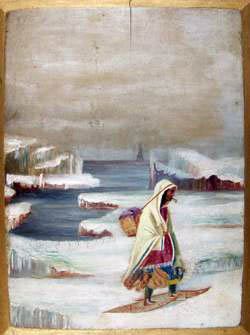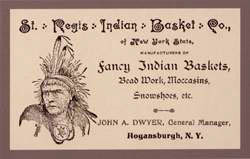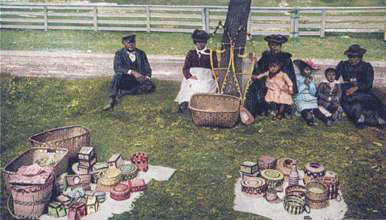Northeastern Snowshoes
Details:
1. Ojibwe Snowshoes, 19th – Early 20th
Century
Loaned by Brenda and Kim Cartwright
2. Cree Beavertail Snowshoes, 19th – Early
20th Century
Loaned by Brenda and Kim Cartwright
3. Lumberman’s Snowshoes, c. 1920
Loaned by Brenda and Kim Cartwright
4. Montaignais Swallowtail Snowshoes, c.
1900
Loaned by Brenda and Kim Cartwright
5. Montaignais Swallowtail Snowshoes, 19th
– Early 20th Century
Loaned by Brenda and Kim Cartwright

Probably painted by
Cornelius Kreighoff, 19th Century
Besides the Maine-stylesnowshoe, other distinctive forms developed in the Northeast. Some were made from a single wooden stave bent in a nearly oval shape. Forms with short tails were called swallowtail and beavertail shoes, while those with no tails at all were referred to as elbow or bearpaw shoes. Other snowshoe forms, such as the long narrow Ojibwe or Cree-style snowshoes, were made from two wooden staves secured at the tip and tail of the shoe.
Northeastern snowshoes were often ornamented with decorative babiche work, tufts of wool, yarn or other materials, and paint to accent babiche designs. It was said that designs in the weaving work were done to please the spirits and to enable the snowshoes to carry the wearer on their journey. Trade cloth and yarn tassels or moosehair tufts not only protected the selvage cords from chafing and wearing out, but muffled the sound of the shoes crunching through the snow as hunters tracked game.
Among many sub-Arctic groups, distinct winter and spring snowshoe forms developed. Winter shoes were made with the rawhide lacing wrapped around the center portion of the frame to provide added traction on icy surfaces. Spring shoes, made for use in wet, loose snow, had a smooth wood frame with the infilling attached from selvage cords. During the course of a single winter season, several different types of snowshoes might be necessary and snowshoe makers crafted the appropriate type of shoe required to meet the needs of the terrain and snow conditions.
 |
“Our snowshoes are the genuine Indian make, rims of white ash, well braced, lacing close and all of the best quality of rawhide.
St. Regis Indian Trading Company, Distributors of Indian Goods, Hogansburg, New York (1917). |

